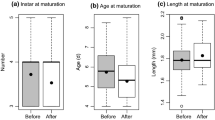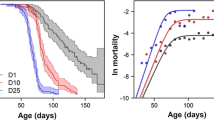Abstract
To test the hypothesis of co-adaptation of life histories and daytime vertical distribution (vertical migration behaviour) in Daphnia, life history characteristics were analysed for two positively, three negatively, and four intermediately phototactic Daphnia magna clones. Clones with different phototactic behaviour were found to have divergent life history strategies, with positively phototactic clones being good exploiters under the non-limiting conditions provided in the laboratory, i.e. low density (1 ind./1), high food concentration (6,5–7 105 Scenedesmus cells/ml, restored daily) and high temperature (20° C). They realized a high intrinsic rate of increase at a small adult body size through rapid development, at a cost of producing small neonates. Negatively and intermediately phototactic clones had larger adult body sizes, and produced larger neonates that were more starvation-resistant than those of positively phototactic clones. Selection for high intrinsic rate of increase in intermediately phototactic clones was mediated through the production of large clutches.
Similar content being viewed by others
References
Brookfield JFY (1984) Measurement of the intraspecific variation in population growth rate under controlled conditions in the clonal parthenogen Daphnia magna. Genetica 63: 161–174
Carvalho GR (1987) The clonal ecology of Daphnia magna (Crustacea: Cladocera). II Thermal differentiation among seasonal clones. J Anim Ecol 56: 469–478
Dawidowicz P, Loose CJ (1992) Metabolic costs during predator-induced diel vertical migration of Daphnia. Limnol Oceanogr 37: 1589–1595
De Meester L (1989) An estimation of the heritability of phototaxis in Daphnia magna Straus. Oecologia 78: 142–144
De Meester L (1990) Evidence for intra-population genetic variability for phototactic behaviour in Daphnia magna Straus, 1820, Biol Jb Dodonaea 58: 84–93
De Meester L (1991) An analysis of the phototactic behaviour of Daphnia magna clones and their sexual descendants. Hydrobiologia 225: 217–227
De Meester L (1993a) The vertical distribution of Daphnia magna genotypes selected for different phototactic behaviour: outdoor experiments. Arch Hydrobiol Beih Ergebn Limnol 39: 137–155
De Meester L (1993b) Genotype, fish-mediated chemicals, and phototactic behavior in Daphnia magna. Ecology 74: 1467–1474
De Meester L (1993c) On the genetical ecology of phototactic behaviour in Daphnia magna (Crustacea: Cladocera). Academiae Analecta 55: 143–188
De Meester L (in press) Habitat partitioning in Daphnia: coexistence of Daphnia magna clones differing in phototactic behaviour. In: Beaumont A (ed) Genetics and evolution of aquatic organisms. Chapman α Hall. London: 323–335
Dodson SI (1989) Predator-induced reaction norms. BioScience 39: 447–452
Dumont HJ, De Meester L (1990) Are contrasting patterns of vertical migration in zooplankton the result of differential natural selection? Rev Brasil Biol 50: 867–874
Duncan A, Guisande C, Lampert W (1993) Further trade-offs in Daphnia vertical migration strategies. Arch Hydrobiol Beih Ergebn Limnol 39: 99–108
Ebert D (1991) The effect of size at birth, maturation threshold and genetic differences on the life-history of Daphnia magna. Oecologia 86: 243–250
Ebert D, Jacobs J (1991) Differences in life-history and aging in two clonal groups of Daphnia cucullata Sars (Crustacea: Cladocera). Hydrobiologia 225: 245–253
Ebert D, Yampolsky L, Stearns SC (1993) Genetics of life history in Daphnia magna. 1. Heritabilities at two food levels. Heredity 70: 335–343
Gabriel W, Thomas B (1988a) Vertical migration of zooplankton as an evolutionarily stable strategy. Am Nat 132: 199–216
Gabriel W, Thomas B (1988b) The influence of food availability, predation risk, and metabolic costs on the evolutionary stability of diel vertical migration in zooplankton. Verh Internat Verein Limnol 23: 807–811
Gliwicz MZ, Pijanowska J (1988) Effect of predation and resource depth distribution on vertical migration of zooplankton. Bull Mar Sci 43: 695–709
Guisande C, Duncan A, Lampert W (1991) Trade-offs in Daphnia vertical migration strategies. Oecologia 87: 357–359
Haney JF (1993) Environmental control of diel vertical migration behaviour. Arch Hydrobiol Beih Ergebn Limnol 39: 1–17
Harvell CD (1990) The ecology and evolution of inducible defenses. Q Rev Biol 65: 323–340
Hedrick PW (1986) Genetic polymorphism in heterogeneous environments: a decade later. Annu Rev Ecol Syst 17: 535–566
Hutchinson GE (1961) The paradox of the plankton. Am Nat 45: 137–145
Lampert W (1989) The adaptive significance of diel vertical migration of zooplankton. Funct Ecol 3: 21–27
Lampert W (1993) Ultimate causes of diel vertical migration of zooplankton: New evidence for the predator-avoidance hypothesis. Arch Hydrobiol Beih Ergebn Limnol 39: 79–88
Leibold M, Tessier AJ (1991) Contrasting patterns of body size for Daphnia species that segregate by habitat. Oecologia 86: 342–348
Loaring JM, Hebert PDN (1981) Ecological differences among clones of Daphnia pulex Leydig. Oecologia 51: 162–168
Loose CJ (1993) Daphnia diel vertical migration behavior: Response to vertebrate predator avoidance. Arch Hydrobiol Beih Ergebn Limnol 39: 29–36
Lýnch M (1984) The limits to life history evolution in Daphnia. Evolution 38: 465–482
Macháček J (1991) Indirect effect of planktivorous fish on the growth and reproduction of Daphnia galeata. Hydrobiologia 225: 193–197
Meyer JS, Ingersoll CG, McDonald LL, Boyce MS (1986) Estimating uncertainty in population growth rates: jackknife vs. bootstrap techniques. Ecology 67: 1156–1166
Müller J, Seitz A (1993) Habitat partitioning and differential vertical migration of some Daphnia genotypes in a lake. Arch Hydrobiol Beih Ergebn Limnol 39: 167–174
Pace ML, Porter KG, Feig YS (1984) Life history variation within a parthenogenetic population of Daphnia parvula (Crustacea: Cladocera). Oecologia 63: 43–51
Pijanowska J (1993) Diel vertical migration in zooplankton: fixed or inducible behavior? Arch Hydrobiol Beih Ergebn Limnol 39: 89–97
Pijanowska J, Dawidowicz P (1987) The lack of vertical migration in Daphnia: the effect of homogeneously distributed food. Hydrobiologia 148: 175–181
Ringelberg J (1991) A mechanism of predator-mediated induction of diel vertical migration in Daphnia hyalina. J Plankton Res 13: 83–89
Sokal RR, Rohlf FJ (1981) Biometry. WH Freeman, San Francisco
Spitze K (1992) Predator-mediated plasticity of prey life history and morphology: Chaoborus americanus predation on Daphnia pulex. Am Nat 139: 229–247
Stibor H (1992) Predator induced life-history shifts in a freshwater cladoceran. Oecologia 92: 162–166
Stich HB, Lampert W (1981) Predator evasion as an explanation of diurnal vertical migration by zooplankton. Nature 293: 396–398
Stich HB, Lampert W (1984) Growth and reproduction of migrating and non-migrating Daphnia species under simulated food and temperature conditions of diurnal vertical migration. Oecologia 61: 192–196
Tessier AJ, Goulden CE (1982) Estimating food limitation in cladoceran populations. Limnol Oceanogr 27: 707–717
Vanni MJ (1987) Colonization dynamics and life history traits of seven Daphnia pulex genotypes. Oecologia 72: 263–271
Weider LJ (1984) Spatial heterogeneity of Daphnia genotypes: vertical migration and habitat partitioning. Limnol Oceanogr 29: 225–235
Weider LJ (1987) Life history variation among low-arctic clones of obligately parthenogenetic Daphnia pulex: a diploid-polyploid complex. Oecologia 73: 251–256
Weider LJ, Pijanowska J (1993) Plasticity of Daphnia life histories in response to chemical cues from predators. Oikos 67: 385–392
Wilkinson L (1990) SYSTAT: The system for statistics. Systat, Evanston
Yampolsky LY, Kalabushkin BA (1991) The components of life-history traits variation in Daphnia magna population. Hydrobiologia 225: 255–261
Author information
Authors and Affiliations
Rights and permissions
About this article
Cite this article
De Meester, L. Life histories and habitat selection in Daphnia: divergent life histories of D. magna clones differing in phototactic behaviour. Oecologia 97, 333–341 (1994). https://doi.org/10.1007/BF00317323
Received:
Accepted:
Issue Date:
DOI: https://doi.org/10.1007/BF00317323




